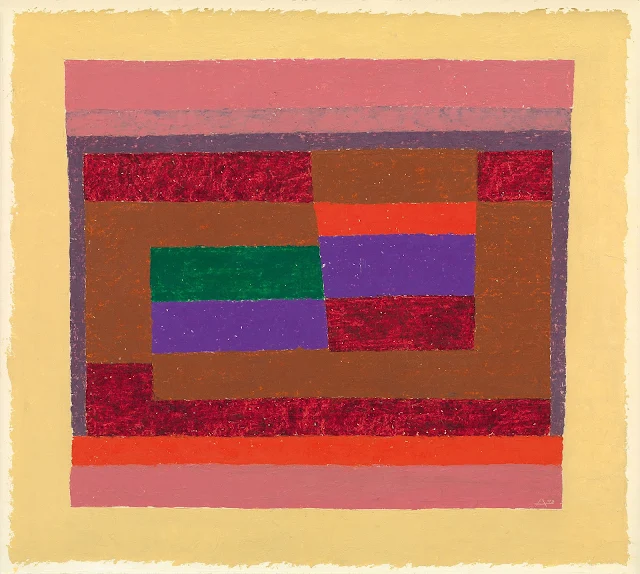The term "Abstract Imagists" originates from a pivotal 1961 exhibition at the Guggenheim Museum in New York, titled "American Abstract Expressionists and Imagists." This exhibition was part of a series aimed at exploring trends in American and European painting and sculpture. The collection showcased works from various artists whose styles, while distinct, shared a common thread of dramatic simplification and symbolic content.
Abstract Imagism is a unique subset of abstract expressionism, characterized by diverse techniques and symbolic expression through isolated and highly simplified elements. The artists associated with this movement often employed geometric forms, compression, intricate canvas elaboration, isolated shapes or signs, detailed overall patterning, and large unified color shapes to achieve their artistic vision. Despite their varied approaches, these artists were united by their quest to distill complex emotions and ideas into their simplest, most potent forms.
Key Techniques
1. Geometric Means: Artists like Josef Albers, Franz Kline, and Hans Hofmann used geometric shapes to create striking visual compositions. Albers, for instance, is renowned for his "Homage to the Square" series, where nested squares explore the interplay of color and form.
2. Compression: Grace Hartigan and George McNeil utilized compression to intensify the emotional impact of their work. This technique involved compacting visual elements to create a sense of density and immediacy.
3. Intricate Elaboration of Canvas Surfaces: Richard Pousette-Dart, Robert Richenburg, John Ferren, and Jimmy Ernst developed complex textures and patterns on their canvases, adding depth and interest to their pieces.
4. Isolated Shapes or Signs: Adolph Gottlieb and Robert Motherwell focused on singular, bold elements to convey symbolic meanings. Motherwell's "Elegies to the Spanish Republic" series exemplifies this approach with its repetitive black ovals and bars.
5. Detailed Overall Patterning: William Baziotes created intricate, all-encompassing patterns that imbue his works with a sense of movement and cohesion.
6. Simplified Structure Through Dominant Color Shapes: Artists like James Brooks, Esteban Vicente, Adja Yunkers, Cameron Booth, and Giorgio Cavallon emphasized large, unified color areas to achieve a powerful visual impact.
Loss of Immediacy
While many artists successfully harnessed these techniques, some critics noted a potential "loss of feeling and immediacy" in the work of certain Abstract Imagists. This critique suggests that the intense focus on form and structure sometimes overshadowed the spontaneous, emotive qualities that characterized earlier abstract expressionist works.
Influential Abstract Imagists
The movement includes a diverse array of artists, each bringing their unique perspective and technique to the table. Here are some of the key figures associated with Abstract Imagism:
Josef Albers
A pioneer in the study of color theory, Albers' work is marked by its geometric precision and exploration of color relationships.
William Baziotes
Known for his biomorphic forms and dreamlike compositions, Baziotes' work often features intricate patterns and a sense of mystery.
Helen Frankenthaler
A central figure in the Color Field movement, Frankenthaler developed the soak-stain technique, which involved pouring thinned paint onto unprimed canvas, creating luminous color fields.
Hans Hofmann
Hofmann's paintings are celebrated for their dynamic compositions and vibrant color contrasts, blending geometric forms with expressive brushwork.
Mark Rothko
Rothko's large-scale color field paintings aim to evoke deep emotional responses through their vast expanses of color.
Jackson Pollock
Famous for his drip paintings, Pollock's work epitomizes the energy and spontaneity of abstract expressionism.
Willem de Kooning
De Kooning's abstract compositions often incorporate gestural brushstrokes and fragmented forms, blending figuration with abstraction.
Barnett Newman
Newman's works are known for their "zip" lines—vertical stripes that run through his large color fields, creating a sense of structure and focus.
Ad Reinhardt
Reinhardt's minimalist black paintings explore the boundaries of perception and the essence of painting itself.
Robert Motherwell
Motherwell's work, particularly his "Elegies to the Spanish Republic," uses bold shapes and a limited color palette to convey powerful political and emotional messages.
Clyfford Still
Still's jagged, color-rich paintings emphasize texture and form, aiming to convey a sense of the sublime.
Frank Stella
Stella's work evolves from the minimalist black paintings of the late 1950s to more complex geometric patterns and relief sculptures.
Ellsworth Kelly
Kelly's works feature simple shapes and pure colors, often exploring the relationship between form and space.
Agnes Martin
Although often associated with minimalism, Martin's grid-based paintings exhibit the meditative, introspective qualities characteristic of Abstract Imagism.
The Impact of Abstract Imagists
The influence of Abstract Imagists extends beyond their individual contributions. Their collective exploration of form, color, and composition has left a lasting legacy in the art world. The movement's emphasis on purity of form and the symbolic potential of abstract elements paved the way for subsequent developments in minimalism, color field painting, and other abstract art movements.
Moreover, the Abstract Imagists' work has had a profound impact on contemporary art, inspiring new generations of artists to push the boundaries of abstraction and explore new ways of expressing complex ideas and emotions through simplified visual means.
Conclusion
Abstract Imagism represents a vital chapter in the history of abstract art. Emerging from the dynamic environment of post-war America, the Abstract Imagists brought a fresh perspective to the exploration of form, color, and symbolism. Through their varied techniques and approaches, they demonstrated the power of abstraction to convey deep emotional and intellectual content.
The legacy of the Abstract Imagists continues to resonate in the art world today, reminding us of the endless possibilities that arise when artists distill their visions to their most essential, powerful forms. As we reflect on their contributions, we celebrate their commitment to innovation, precision, and the enduring pursuit of artistic expression.





.jpg)







No comments:
Post a Comment